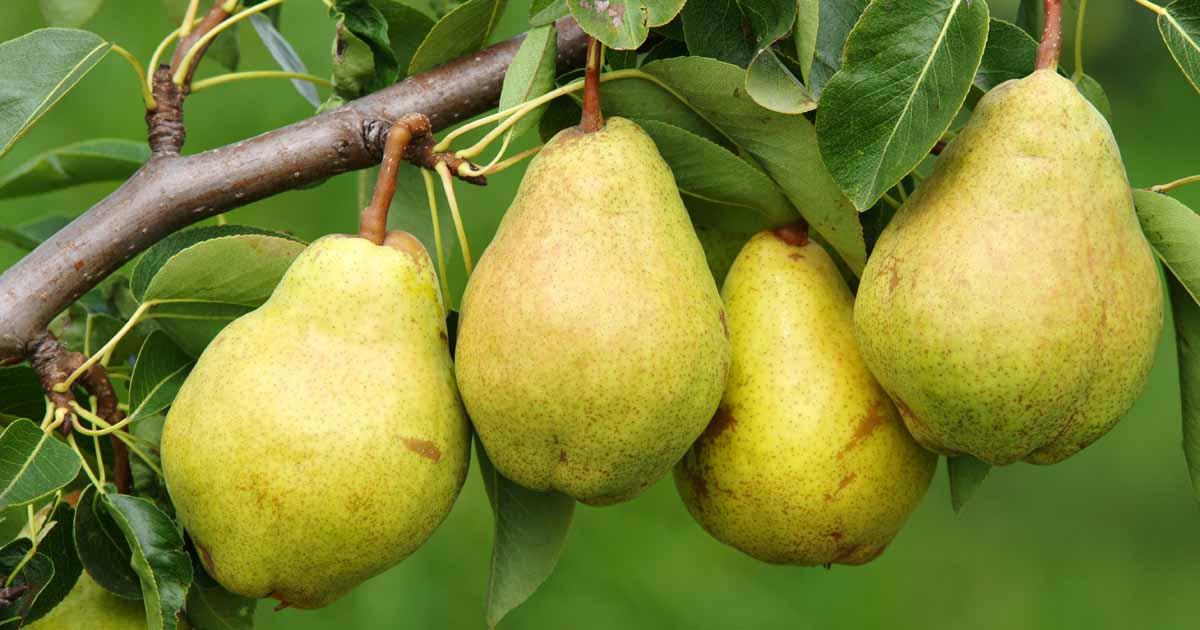Pear (Pyrus spp.)
Introduction
Pear (Pyrus spp.) is one of the most important temperate fruits worldwide, second only to apples. It belongs to the family Rosaceae and the subfamily Pomoideae. Pears are valued for their delicious taste, nutritional benefits, and adaptability to different agro-climatic conditions.
Chromosome Number and Genetic Diversity
- Pear (Pyrus spp.) belongs to the family Rosaceae and has a basic chromosome number of x = 17.
- Most cultivated pears are diploid (2n = 34), but some species can be triploid or tetraploid.
- High genetic diversity exists between European (Pyrus communis), Asian (Pyrus pyrifolia, Pyrus ussuriensis), and hybrid pears.
Origin and Distribution
- Pears are believed to have originated in the mountainous regions of China and spread to Europe and other parts of the world.
- They are widely cultivated in Europe, Asia, North America, and India (Himachal Pradesh, Jammu & Kashmir, Uttarakhand, and hilly regions of Uttar Pradesh).
Importance and Uses
- Pears are rich in carbohydrates, vitamins (A, C, B-complex), and minerals (calcium, phosphorus, sulfur).
- They are easily digestible and beneficial for gut health.
- Used in fresh consumption, juice, jam, jelly, wine, and canned products.
- Pear wood is used for making musical instruments and furniture.
Climate and Soil Requirements
Climate
- Pear trees are adaptable to various climatic conditions, from temperate to subtropical regions.
- Temperature tolerance:
- Can withstand -26°C during dormancy and 45°C during growth.
- Most cultivars require 1200 chilling hours (below 7°C) for uniform flowering and fruit set.
- Humidity and rainfall:
- Prefers moderate humidity.
- Annual rainfall of 1000–1500 mm is ideal, with good drainage.
- Drought tolerance: Less than apple but more tolerant to wet soils.
Soil
- Grows well in deep, well-drained, fertile clayey loam soil.
- Prefers neutral pH (6.0–7.5); tolerates slightly acidic to alkaline soils.
- Waterlogged soils should be avoided to prevent root rot.
Pear Varieties
Classification of Pears
- European Pears (Pyrus communis) – Soft flesh, juicy, preferred for fresh consumption.
- Asian Pears (Pyrus pyrifolia, Pyrus ussuriensis) – Crunchy, grainy texture, used for fresh eating and processing.
- Hybrid Pears – A cross between European and Asian pears with improved disease resistance and adaptability.
Important Cultivars
|
Type |
Cultivars |
Characteristics |
|
European Pears |
Bartlett, Anjou, Flemish Beauty, Starcrimson, Jorgonelle |
Soft, juicy, good for fresh eating. |
|
Asian Pears |
Nijisseiki, Hosui, Shinseiki |
Crisp texture, high sugar content. |
|
Hybrid Pears |
Kieffer, Gola, Le Conte, Patharnakh |
Hardy, disease-resistant, adaptable to warm climates. |
Propagation and Rootstocks
Propagation Methods
Pears are mainly propagated through:
- Budding (T-budding, Patch budding) – June to September.
- Grafting (Whip & Tongue Grafting) – December to February.
Rootstocks Used
|
Rootstock |
Characteristics |
|
Pyrus communis (Seedling) |
Vigorous, deep-rooted, good anchorage. |
|
Quince (Cydonia oblonga) |
Dwarfing, early bearing, better fruit quality, but less cold-hardy. |
|
Kainth (Pyrus pashia) |
Used in hilly regions, resistant to drought. |
Orchard Establishment and Planting
Field Preparation
- Land is plowed and leveled a year before planting.
- Drainage and irrigation channels should be established to avoid water stagnation.
Planting Method
- Spacing:
- High-density planting: 3m × 2m (later adjusted to 6m × 4m).
- Traditional planting: 6m × 6m.
- Pit preparation:
- Size: 1m × 1m × 1m.
- Filled with topsoil + 10 kg FYM + 500g SSP + 50g ZnSO₄.
- Planting Time:
- December–January (bare-root planting).
- July–August (container plants).
Training and Pruning
Training Systems
- Modified Leader System (common for open fields).
- Palmette System, Tatura Trellis (used in high-density planting).
Pruning
- Pears bear on two-year-old spurs and remain productive for 6–10 years.
- Winter pruning encourages new growth.
- Summer pruning helps remove excessive shoots.
Nutrient and Water Management
Nutrient Requirements
|
Age |
N (g/tree) |
P (g/tree) |
K (g/tree) |
|
1st Year |
50 |
20 |
50 |
|
5th Year |
300 |
75 |
150 |
|
10th Year |
600 |
150 |
300 |
- Nitrogen is applied in two splits (January and May).
- Phosphorus and potassium are applied before flowering.
Irrigation
- Young plants require regular irrigation every 10–15 days.
- Critical stages:
- Flowering and fruit set.
- Fruit development (June–July).
- Drip irrigation is preferred for better water use efficiency.
Pest and Disease Management
Major Pests
|
Pest |
Damage |
Control Measures |
|
Pear Psylla |
Sucks sap, leads to defoliation. |
Spray Imidacloprid (0.01%). |
|
Fruit Borer |
Damages developing fruits. |
Carbaryl (0.1%) spray. |
|
Aphids |
Causes curling of leaves. |
Use Neem oil (2%). |
Major Diseases
|
Disease |
Symptoms |
Control |
|
Fire Blight |
Blackened shoots, wilting. |
Spray Streptomycin (500 ppm). |
|
Pear Scab |
Dark lesions on leaves & fruits. |
Mancozeb (0.3%) spray. |
|
Powdery Mildew |
White powder on leaves. |
Apply Sulfur dusting. |
Harvesting, Yield, and Storage
Harvesting
- Pears are harvested when firm and green for long-distance transport.
- Maturity indices:
- Fruit firmness (4.5–6.5 kg/cm²).
- Change in seed color from white to brown.
Yield
- Average yield: 30–40 tonnes/ha.
- European pears yield higher than Asian pears.
Storage & Ripening
- Cold storage: -1°C for up to 5 months.
- Ripening:
- 3–6 days at 15–25°C, 80–85% RH.
- Ethylene treatment (100 ppm) speeds up ripening.


